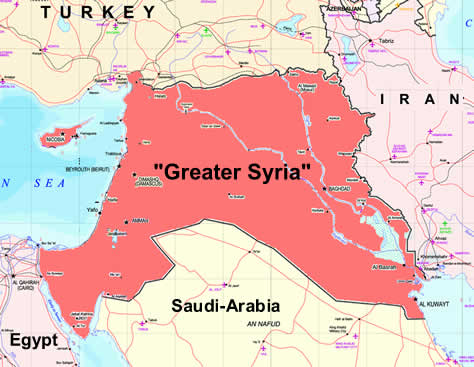Some questions are plaguing Middle East analysts over the sudden shift in Israeli-Syrian relations. Ehud Olmert’s attitude is quite obvious – he wishes to use every trick in the book, to avert public attention on his looming corruption charges. A so-called peace agreement with Syria could even convince those skeptics, who have long ago marked him as one of Israel’s worst leaders and a political scoundrel. Even in Washington, last Wednesday, President George W Bush was wondering whether his bosom friend Ehud Olmert knows what he is doing. In spite of relented efforts in Jerusalem to calm the ruffled feathers with the angry Bush administration, Israel seems to be heading towards a cooling-off period, if Olmert will continue his dubious steps in saving his political hide. No doubt, Olmert’s decision to go public with Israeli-Syrian rapprochement efforts is regarded by many Israelis as a crude gambit to distract attention from a criminal investigation that could force him from office.
But what has brought young Bashar Assad, hitherto regarded as virtual nincompoop and a tool in the hands of the Syrian old guard of conservative generals and advisers and seemingly “loyal” vassal to his Iranian mentor Ahmadinejad, to take such an unprecedented step with Israel? Surprisingly though, Bashar Assad could prove after all to be quite a shrewd operator, even a chip of the old block, his father had presented for decades. Bashar, was regarded a tool in the hands of the Syrian old guard of conservative generals and advisers. However, quite surprisingly, young Assad has sofar managed to survive all proceedings investigating the assassination of former Lebanese prime minister Rafik Al-Hariri, to draw him and his entourage into the international court hearings. He even went as far last April, to place his brother in-law, strongman General Assef Shawkat under heavily guarded house arrest, following the mysterious assassination of Lebanon’s Hezbollah commander Imad Mughniyeh. The German prosecutor Detlev Mehlis had implicated General Assef Shawkat, then Syria’s intelligence chief, in the plot to murder of Hariri. Would he be made the scapegoat, by his brother in-law, when finally push comes to shove in this pending murder case to name a culprit and save the president himself?
According to Israeli analysts, the strategic partnership between Syria and Iran may be placed on less solid ground, than Israeli intelligence had suggested in its latest assessments. Tehran appears clearly surprised by the actions of its partner in Damascus. According to the London-based Al-Sharq al-Awsat, reports coming out of Tehran already indicate growing tensions between Iran and Syria, following the talks with Israel – especially their being made public simultaneously, in Damascus and Jerusalem. The same sources had mentioned last September, following the alleged Israeli air force strike, which foreign media said, had targeted a nuclear reactor in northern Syria, that the Iranians had not been part of the secret project; President Bashar Assad was working with North Korea.
It is no secret that an alliance with Iran is of great value for Syria, both for its strategic implications and for its financial benefits. Yet at the same time there is little love in Damascus for these fundamentalist allies. Syria would much rather be embraced again by Saudi Arabia and the Sunni Arab world and especially, the United States. The Egyptian precedent – the American billions that poured into Cairo after the peace accord between Egypt and Israel, are regarded longingly in Damascus to save the miserable economy. But the known price seems to hard to swallow, even at this stage, in which Syria is more and more isolated by it’s neighbors.
Extricating Syria from Iran, which includes petro-dollars funding Damascus’ procurement of weapons from Russia and growing Iranian influence on Damascus, is considered a central consideration behind Israel’s decision to renew negotiations. Damascus is perceived to be a key partner of Tehran and weakening its ties with Iran may have far-reaching effects on militant groups heeding to instructions from Iran, such as Hezbollah and Islamic Jihad – and to a lesser extent, also Hamas.
Is Syria really moving towards wriggling itself from the Iranian Shi’ite bear hug? Maybe Bashar Assad’s present maneuvers are merely a shift towards Syria’s long-term strategic and national ambitions, which could stabilize his own Alawite position within the Sunni majority state?
Indeed, there may be more involved in the present drama than meets the eye. If Ehud Olmert will achieve the impossible and Israel will agree to withdraw from the strategic Golan Heights, hundreds of thousands Syrian residents will immediately be settled in the Golan. According to senior analysts Dr Guy Bechor, even though the Golan Heights are presently not in Syrian hands, a presidential decree has already been issued announcing that any Syrian resident who moves to the Golan will receive a government allowance. This is what the Syrians did in Lebanon in order to take it over. While the Syrian army was forced to withdraw from Lebanon, following the Hariri assassination in 2005, the Syrians ostensibly left 800,000 laborers behind who work in Lebanon and transfer their salaries back to Syria. And so, the Syrian chokehold on Lebanon has remained intact. In fact, all major political events since, have been marked with Syrian colors.
Once the Golan Heights are under Bashar Assad control, he will realize Syria’s aspirations with no interruptions – establishing a “resistance” against Israel in the Golan Heights. Officially, he will argue that he has no connection to the terror attacks that would be directed at the Galilee region and northern Israel from the Golan, yet in practice Syrian intelligence officers will do as they please vis-à-vis northern Israel. In fact, they already did for years it in northern Lebanon and to a lesser extent, among the Druze settlers in the northern Golan height.

But there is much more at stake here. In Arab-Muslim historical geography, today’s Syria and Lebanon, alongside Jordan and northern Israel (mainly the Galilee), are all part of Greater Syria, known in Arabic as Bilad al-Sham. Ever since its foundation by the French mandate authorities the Syrian nationalists refused to acknowledge independent political entities in Lebanon, or even the Galilee and Jordan Valley, considering it the western part of Greater Syria.
Syrian forces fought in the 1948 war to maintain hold on northern Palestine, as soon as the British left, but were chased out by Zahal. However, unfortunately for Israel, the so-called “Galilee Triangle”, still has a clear Arab-majority. As negotiations between Israelis and Palestinians started in the early nineties, there is also a strong motivation developing for autonomy among Israeli Arabs and is gaining momentum by Islamic groups in Northern Israel. Arab Israelis demanding a cultural and political autonomy that would enable them to manage their own lives while disconnecting from the State of Israel’s “Jewish” institutions. During the latest “Earth Day” rallies, protesters already openly called for political autonomy for Arabs in the Galilee. The quest to establish “facts on the ground” has now shifted to the Galilee, where there are several districts that already have a considerable Arab majority. According to the Israeli government statistics, Arabs comprise 18.6 percent of Israel’s population, but 46 percent of northern Israel, and many say a clear Galilee majority helped by 50,000 Arab “settlers,” as some call them, from the nearby West Bank. Many predict that the Galilee Arabs will want political autonomy of their own.
There may well be a sinister aim behind Bashar Assad’s present motive- to negotiate a peaceful return of the Golan Heights to Syrian sovereignty. Viewed by sheer topgraphical features, the Golan Heights are dominating the Israeli Jordan valley, the so-called Panhandle, which is barely five to seven kilometers wide. On it’s western side, the Galilee mountains, bordring with Lebanon, are topgraphically controlling the same Panhandle, making any attempt to defend this sensitive region virtually impossible. Thus, once the Golan Heights are bak on Syrian hands, the way towards gaining access to northern Israel is wide open.

Such a bold move could not only enhance Syria’s prestige in the Arab world and to further its greatest national cause: but realize the age old dream of a “greater Syria” in the Middle East. Restoring the Golan Heights has become an inalienable principle in Syrian foreign policy. Control of this strategic and topographic area, will enable Syria to a re-assert it’s control, not only over South Lebanon, but strive toward gaining political access to influence an Israeli-Arab autonomy, if such will come into effect. From there a Greater Syria, also known (in a historic context) as Syria, or Bilad ash-Sham is only a stone throw away.
There is also another aspect to the present Syrian aspirations, which should not be overlooked, even if at present somewhat far fetched. For years, Al Qaeda has envisioned creating an Islamist state in the Greater Syria region. This strategy would create a keystone for operations at the nexus of three continents, create a large recruiting base, and allow for attacks on Israel. The opening of the Greater Syrian jihad shows intent to adopt a quasi-nationalistic approach to the Global Jihad and exploits the religious, cultural, and political divides in the area. The history of Islamist organizations in Greater Syria indicates that Salafist organizations are able to maintain operations and have recently begun to grow. Abu Musab al-Zarqawi, the former head of Al Qaeda in Iraq was instrumental in linking Greater Syrian Islamist groups to the larger Al Qaeda Global Jihad network.
Politicized Islamic ideologies have appeared in Greater Syria throughout history, but the most noteworthy has been in recent years. Within the past year, Fatah al-Islam has risen from a low-level group to a preeminent terrorist organization. Other terrorist organizations in the region are likely enjoying attention from the transnational Islamist community.
Two Islamist ideologies have thrived in the Greater Syria region throughout history. Wahhabism has made appearance with groups connected to the Saudis in the eastern Arabian Peninsula. Salafism has lingered in areas of Greater Syria, but has grown in recent years. Salafism is often considered the most extreme and violent of all Islamist ideologies. In 1918, Abd el Kader el Jesairi, of Algerian decent, was placed as de facto rulers of Damascus by the Ottoman Empire. Abd el Kader was a known Salafist and promoted Islamism as a means of controlling Greater Syria. More recently, Islamism, especially Salafism, has developed in Greater Syria. In the 1980’s, Islamist terrorism began with the formation of Asbat al Ansar. The group was created in the Ain al-Hilwah Palestinian refugee camp near Sidon.
The use of “ash-Sham”, or Greater Syria, may be an attempt to hijack the Pan-Syrian ideology, which centered on the recentralization of Greater Syria after the division of the Sykes- Picot Agreement. The Arab Republic of Syria had been the standard bearer of Pan-Syrianism, but more recently has focused on regime survival. If Al Qaeda is able to exploit the ideology, it may gain more support for the elimination of current regimes in the region.
Taking all this sinister prophesy in account should warn the Israelis, that their prime minister Ehud Olmert is actually playing with a highly contagious fireball.

















